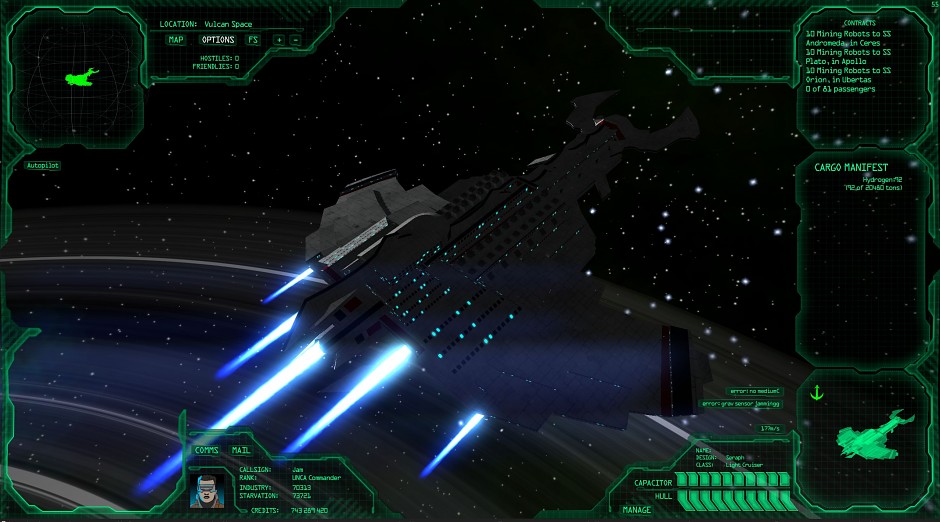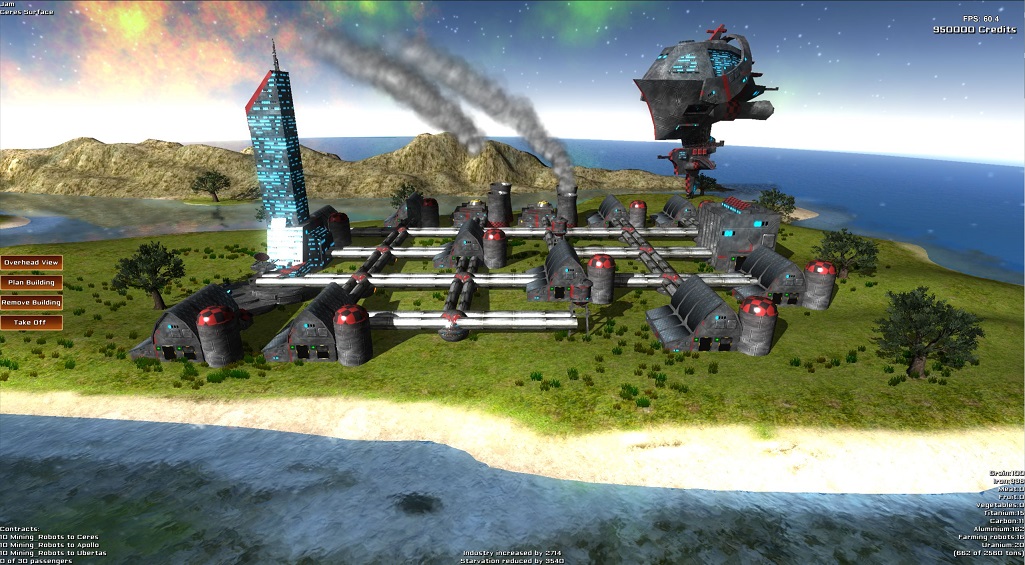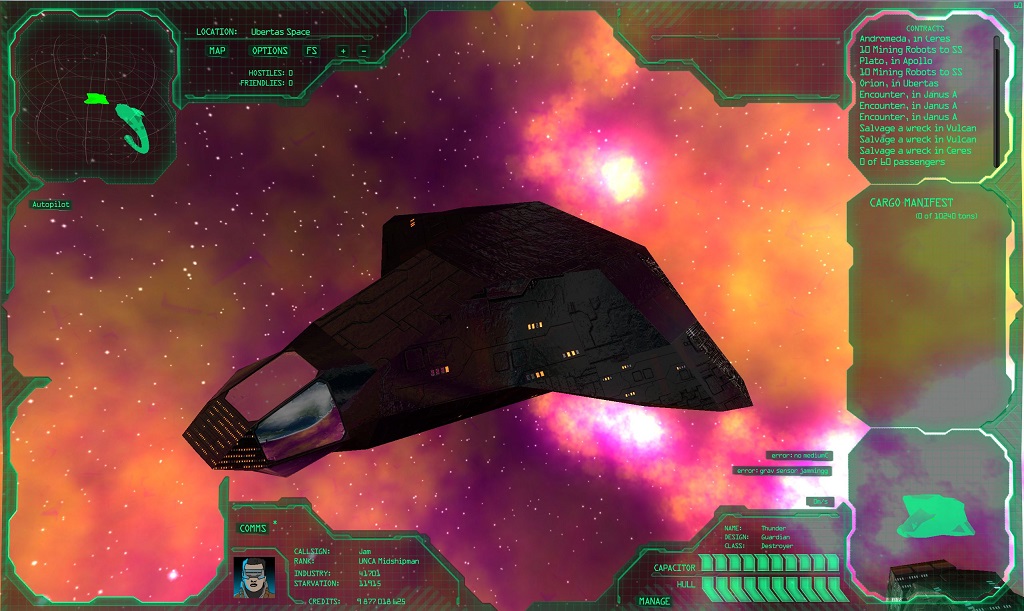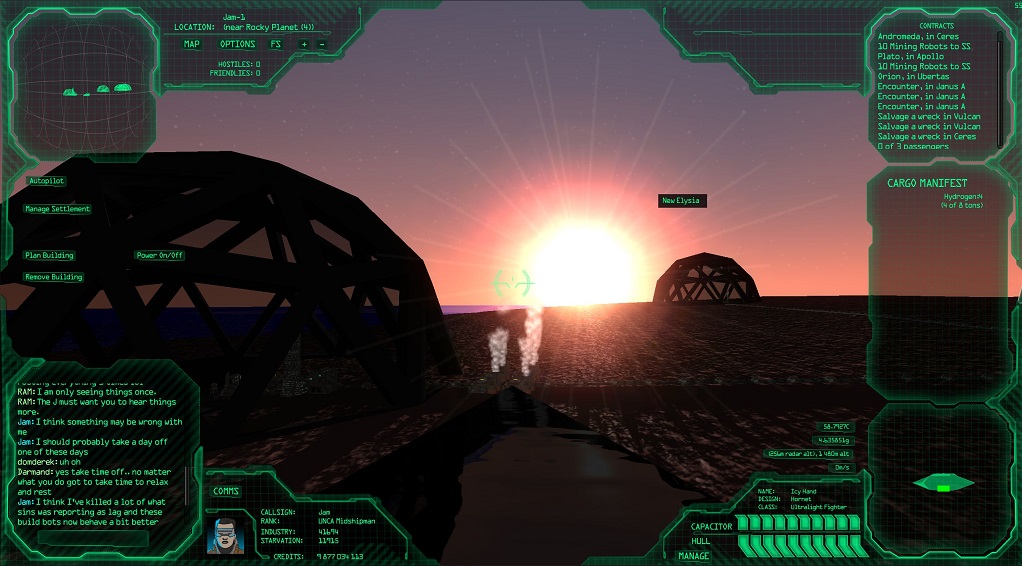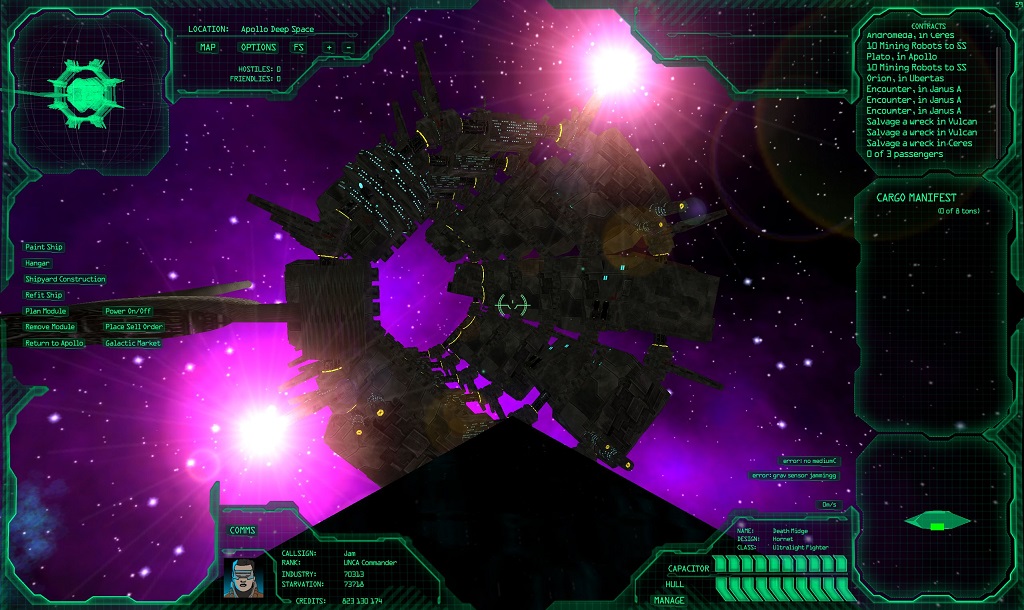 Let’s Chat about Ascent, The 270 Billion Star System Space MMO
Let’s Chat about Ascent, The 270 Billion Star System Space MMO
with Julie Morley
[divider]Ascent is a PvE space-oriented MMO with over 270 billion star systems to explore and it is on Kickstarter, aiming to raise $35K. It is developed by Australian studio, Fluffy Kitten Studios, and has been undergoing development since January. I was fortunate to interview James Hicks, founder of Fluffy Kitten Studios, and developer and creative genius behind Ascent itself. Here’s what he had to say.
[divider]Cliqist : For our readers who are unfamiliar with Ascent, could you tell us a little bit about it?
James Hicks : Ascent is a Player vs. Environment space MMO with a huge open game world (270 billion star systems, full earth-sized planets) and cooperative sandbox play. Ascent is a completely new take on the genre; in each and every feature, we manage to do things nobody has tried before. Combat difficulty ramped up by smarter AI rather than just throwing more ships at the player. Asteroid mining that’s entertaining and challenging instead of just a grind. A complete, open-ended city building game based around colonizing all of those hitherto lifeless worlds. These are just a few examples of what Ascent is all about.
Cliqist : What inspired the concept for Ascent? What about the lore?
James Hicks : For me, the journey began while playing Frontier: Elite II years ago. I loved that game to death, but I always wanted to do more in it. You couldn’t build your own ships or starbases, colonize or terraform worlds, or get out of your ship and walk around—and you couldn’t interact with other players at all, or with NPCs to any great extent. I think the dream began to evolve from there. I played EVE Online for several years and loved it—but I’ve never enjoyed blowing up other peoples’ stuff, and I really felt there was a vast gap in the market for a game that didn’t focus on this at all. Sci-fi and space are about so much more than violence—and definitely so much more than humans killing other humans for fun and profit.
I’ve been refining and adding to the ideas behind the gameplay for a couple decades. I found myself constantly thinking, ‘Wouldn’t it be awesome if there was a game where you could . . .?’ and just collecting those wacky ideas. I know mainstream gaming companies won’t touch a lot of things we’ve done and plan on doing—because frankly, the technical risks are dire. I honestly didn’t know if many of these things were possible at all! So the choice was between continuing to just dream and never see it happen—or to get in there and try to do it. The ability, or at least the chance, to implement some of these ideas has just recently arrived with the latest generation of cloud computing and game engines, so it was time to quit my job and give it my best shot.
In terms of the setting/lore, I’ve always wanted someone to bring in a new take on the “post-apocalyptic” genre. In this case, the game is set at the tail end of a catastrophe—and the players can work together to turn things around, preserve what’s left, and build something new. To me, this avoids the feeling of oppressive hopelessness that ‘post-apocalyptic’ usually delivers, while still leveraging that sense of desperation and desolation—and ramping up the survival stakes to the max. There’s also an evolving mystery of “what really happened?” that ties into the main quest line of the game and gives plenty of room for expansion of the story as time goes by. We already have several fan fiction authors working away at it and posting their theoretical histories on the forum—some of which may become “canon” in the future.
Cliqist : If unanswered in the previous question, what inspired you to design the game as an MMO in particular?
James Hicks : I’ve always pictured the game as an MMO, and that’s been really the core of its design from the ground up. I’ve been in love with MMOs since Everquest, and I’ve just never been able to picture Ascent without other players, cooperative projects, player-to-player trading, etc. For example, the chat and “see other ships” functions immediately changed the entire feel of the game for the better. It would be incredibly sad to build a huge colony if nobody ever came to visit.
As a sandbox MMO, the other players are literally building the world you’re experiencing. There really is a vast empty void of lifeless space out there in this game, as well as an ongoing “are we alone?” mystery—and while that creates a kind of vacuum-magnet for player expansion, it would also be that much more confronting if we each faced it alone . . . not to mention more of a grind. Inevitably, there are some elements of play you will enjoy more than others, and (as we keep expanding the game’s features) some elements you don’t want to get into at all. With other players around, you can use trade to solve that problem.
Cliqist : You stress in the Kickstarter campaign that Ascent is science fiction backed with real science – could you give an example of this?
James Hicks : There are a lot of examples, but probably the best would be the star systems and their contents. While writing the generation code for the Milky Way, we didn’t just use NASA imagery for the shape, dimensions and density. I spent weeks researching everything I could find on the theoretical and observed formation of stars, star systems and planets. I looked in detail at the Kepler mission’s findings on the statistical presence of planets in nearby star systems. All of that research went straight into the game engine. Things like mass, spectrum, radiation and volume of stars, the placement of the first gas giant in a star system, the composition and state of gases, liquids and solids on the surface of planets, planetary climate, the chemical compositions of soil on various planets and moons, the location of whole moons versus rings or asteroid fields, etc. If you are an astronomer and play Ascent, you will see everything where you expect it to be—because we tried to replicate reality within the simulation.
I realize it might seem strange that we went to that level of detail (and I’ll admit a big driver for it was pure obsession), but there are a lot of advantages. First, our galaxy is internally consistent because it’s based on the real one. Suspension of disbelief is easy because you’re confronted not with a theme park, but a simulation—and the deeper you look, the more of that consistent alternative reality you see. Second, scientific depth leads to science fiction depth—which informs gameplay without having to make up too much stuff and risk breaking that feeling of reality.
A good example of this is the exploration game. You can reprogram various sensors and modules on your ship to give you readouts of things such as temperature, pressure, atmospheric and ocean chemical composition, to analyze soil samples for mineral traces, or core sample individual locations for their local mineral composition. Why would you want to, though? Is there some scoring or experience system for exploration? Nope! If you’re the first player in a star system, it’s initially named after you—and you’re permanently recorded as the discoverer. But all of that information you gather, if you choose to gather it at all, is really only relevant to the next phase—which is the colonization of the system and the exploitation of its resources. What gases are in the atmosphere or liquids in the ocean are critical to being able to construct environmental domes and make them habitable—and in future, for terraforming that planet or a moon. The soil analysis will tell you what crops (if any) you can grow, and what resource types you can mine.
Briefly getting back to the MMO aspect: If you aren’t interested in all of those factors (e.g., exploring systems, building colonies, mining), you can trade the information with other players and just get on with the style of play you like best.
Cliqist : Though there is no PvP in Ascent, can players interact with each other in any way? Say, trading, for example?
James Hicks : Yes—the first three elements we added were chat, trading, and being able to see other players’ ships in space . . . but it’s gone far beyond that now. Pretty early on, players began cooperating and forming organizations within the game. There was a cooperative spreadsheet floating around at some point with the data about hundreds of explored worlds on it. Nowadays, colonists vote in elections that appoint players to Colony Mayor, Planetary Governor, System Senator and a Colonial President position. These positions have real power in the game—and are able to rename planets/star systems and plan/approve the construction of player-made jump gates.
These jump gates are cooperative mega-projects. The first pair was completed only recently—actually connecting the new colonial capital (where a lot of big players have a colony and a large proportion of the 3.5 million colonists out there now live) with the original “inner nine” systems where newbies spawn and learn about the game. What this actually means is that the players have come together and expanded the newbie zone to include their own worlds and colonies! To get the job done, even though it’s a relatively short distance being bridged (materials requirements are exponential based on the distance between the gates), virtually the entire experienced player base worked together for weeks.
We do plan on adding PVP in the future, but it will be contained to designated zones and never impinge on the PVE or nonviolent play in any way. I also don’t yet have that compelling “new take” on how to do it yet, and I don’t want to start until I do.
Cliqist : In the future, do you plan to expand the game modes beyond Combat and Industrialist?
James Hicks : Absolutely. Two of my goals in the next four months are to bring individual and colony artificial intelligence (AI) to life—allowing populations and individual non-player characters (NPCs) to have their own needs, agendas, thoughts, plans and actions. The ultimate goal is to use the vast cities and starbases that players have been constructing this year as a setting for a swathe of new adventures. In the future, I want players to be able to make a complete living off of smuggling, bounty hunting, investigating crimes, spying and stealing technology or information, abducting people, assassination, etc.
I know it sounds a little far-fetched, but bear in mind this game’s development began in January last year—and look at what we’ve been able to achieve so far! These goals, while definitely out there (and possibly a little crazy), are certainly achievable.
In reality, these two original “modes” of play are intertwined—and most experienced players become proficient in both areas. They were added to change the starting position and give new players the shortest route into the style of play they are most interested in. So with that in mind, in the future I expect to add other starting positions for bounty hunter, smuggler, etc. to achieve the same goal—dropping players right in the middle of the experience they’re seeking, as quickly and smoothly as possible.
Cliqist : Players can colonize planets and build cities in Ascent. What is the process like for this? What are players capable of creating/designing in their cities?
James Hicks : This mode of play began as a simplified tutorial-style city building game in the inner nine systems. Newbies still encounter it first in that way: There are 8 planets you can settle in these inner systems, and you get a little 5×6 grid on which to build a city and produce iron or titanium or fruit or whatever that planet produces—balancing bonuses from power, water, housing near your production buildings, etc. This remains a good introduction to the colonization game, familiarizing you with the concepts and what each type of building does.
In May of this year, we enabled colonization of the outer star systems. Given that planets out there can be up to the size of Earth, there is no shortage of space—and I really wanted to go completely overboard with the open-endedness of this feature. So when you establish a colony out there, you get a 100-kilometer radius area of the planet—and there is no hard coded limit on the number of structures you can construct. The largest city out there so far has over 50,000 buildings and is still growing. There are no restrictions on the design and layouts, so you see a huge variability in these things, too. There’s a bit of Minecraft in it; you see people spelling out huge signs in the shapes of their planned transport grid network, etc.—but for the most part, you see domes clustered over the richest mineral deposits and the most fertile soil . . . with some compromises for aesthetics.
It’s far more difficult and involved, of course. None of these planets are in a habitable state (incredibly rare in the galaxy), so most buildings need to be constructed inside an Environmental Dome that’s been correctly configured and managed into a habitable state. That means literally adjusting the contents of its atmosphere, gravity, radiation, temperature and pressure into habitable levels. Next, these colonies have no external support whatsoever, so instead of things like power and water supply giving bonuses, they’re now pre-requisites for productivity. But the payoff is very much worth it. For one thing, you can produce huge quantities of resources at colonies—and you can build a Stock Market out there in which other players can come and trade. You can configure a stock market to buy what your colony needs (what it can’t produce itself) and sell what it produces. In addition, your colony’s population gives you political influence. A large colony, or several large colonies, make you a big player in politics within the game—very often a Senator or Governor, or at least someone with a big influence on electing such positions.
Cliqist : This is the season of space-oriented simulation and exploratory games, isn’t it?
James Hicks : Absolutely. I love that the genre’s coming back into vogue, and I love that everybody’s got a unique take on it. There are a few games in particular I’m looking forward to playing myself—Star Citizen and Elite: Dangerous heading the list. I think we have a unique take on the genre: PVE-focused, no violence unless you seek it out, strong science based sci-fi, a simulation rather than a theme park, total commitment as an MMO from the ground up, etc. I think there’s room for us and everyone else, in what I expect to be a large and growing market. There are millions upon millions of “space” and “sci-fi” fans out there who don’t play these kinds of games yet. I want to find all of them and give them a taste of it!
Cliqist : How will the voting system be organized in Ascent? Is it done through the game or on Ascent’s website? Secondly, will their votes only affect construction of jump gates and systems or will this impact a story in Ascent?
James Hicks : At present, voting takes place through the game itself—although a lot of the political discussion occurs on a special part of the game’s forum designated for politics, where posts are required to be expressed in-character without discussing game mechanics . . . solely focusing on the political issues at hand. Once you have been elected to a given position, you can act on the powers it provides you at will.
Politics currently only lends itself to naming systems, planets, and the planning and approval of jump gates. However, quite soon the plan is for colony Mayors to be able to set laws for their colonies—which will seriously impact the development of their society. Things like the prohibition or legalization of certain goods, the colony’s economic model, the provision of health and education, and so forth. The idea being that we want colonies to further specialize—not just in the resources they produce, but in the kind of society they present and the adventuring environment they provide.
In addition, given that we have an in-game voting system, we can use it for anything. It’s configurable to either ignore or take into account the populations of the colonies you own—so you can have one vote as a player, or a million depending on what we’re voting on. This will allow us to vote on game mechanics issues down the track when and where it makes sense to do so.
Cliqist : If you could describe Ascent in five words, what would they be?
James Hicks : PVE Space MMO, 270,000,000,000 Systems.
[divider]Thanks to James for taking the time to answer our questions! To learn more about Ascent be sure to check out the Kickstarter campaign. You can keep track of the Ascent Kickstarter campaign by visiting its entry on our Campaign Calendar.
[divider][Google][pinterest][follow id=”Cliqist” size=”large” count=”true” ] [author image=”http://cliqist.com/wp-content/uploads/2014/01/julie.jpg” ]Julie Morley is a freelance writer and comic artist from Spring, Texas. She attended the Academy of Art University for two years, studying Animation and Illustration. Whilst here, she learned about writing comic scripts, storyboards, and general storytelling. Since leaving college, she has been working on personal comic projects, stories, and illustrations. She aspires to release a self published comic within two years. For the majority of her life, she has been playing console games, typically being third-person shooters and sandboxes. Her favorite game of existence is Dark Cloud II (Dark Chronicle) and her favorite Indie game is Gone Home.[/author]


